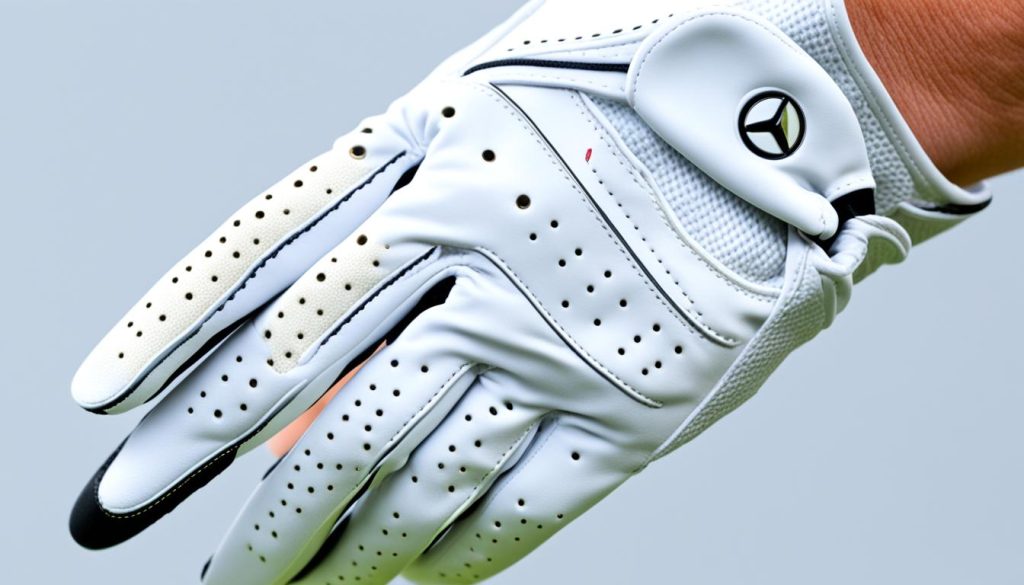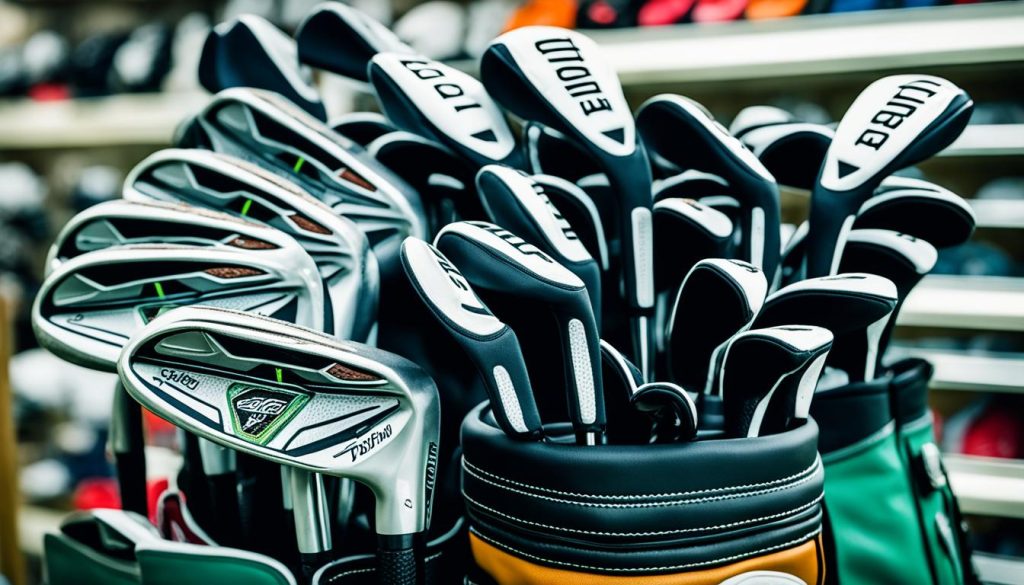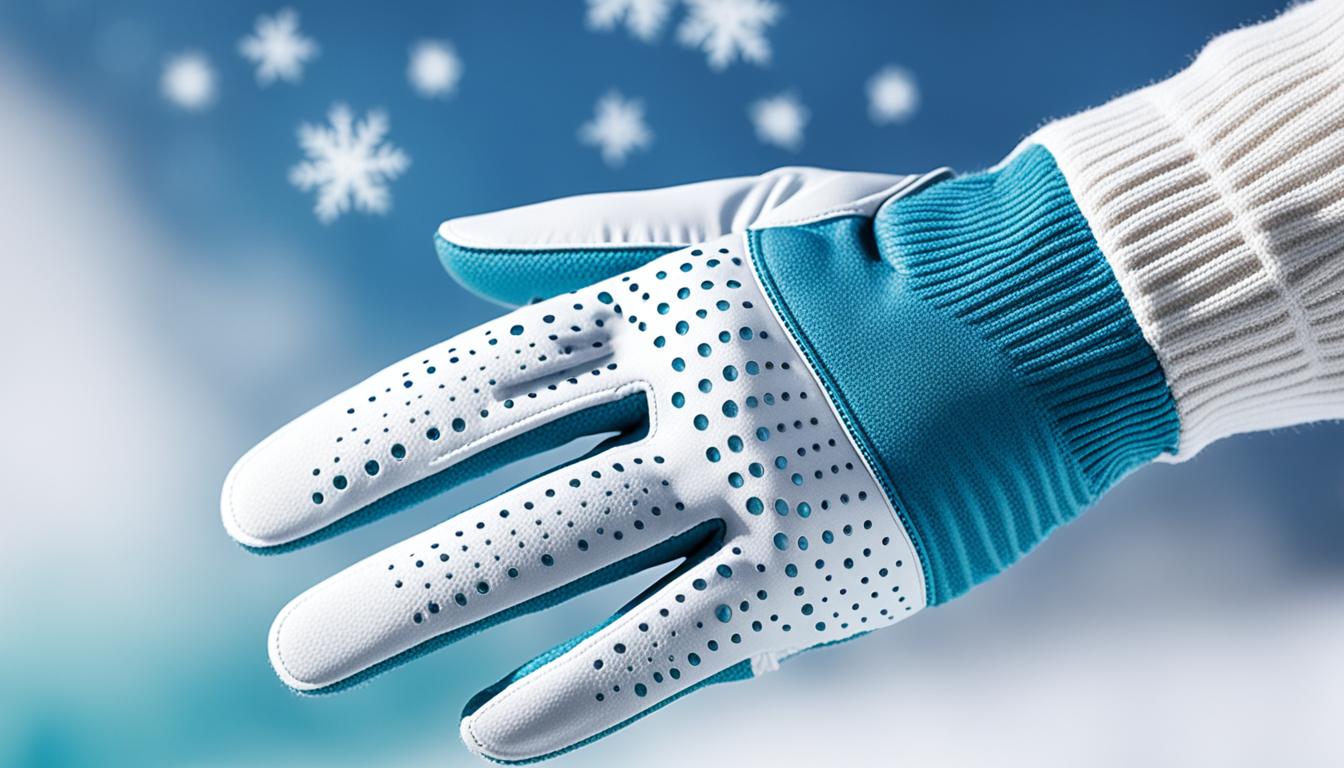Imagine standing on the lush green fairway of a beautiful golf course on a sunny day. The sound of chirping birds fills the air, and the anticipation of the perfect swing builds within you. But as you grip your golf club, you can’t ignore the slight slipperiness in your hand. You realize that your women’s golf gloves might be worn out and in need of replacing.
Women’s golf gloves are an essential tool for any golfer, providing grip, comfort, and protection. However, like any piece of equipment, they can wear out over time. But how do you know when it’s time to bid farewell to your trusty gloves and welcome a new pair into your golf bag?
Worry not, because in this article, we will explore the wear indicators that will help you determine if your women’s golf gloves need replacing. By paying attention to these signs, you can make sure that you have the optimal grip and performance on the golf course, and always be ready to take that winning shot.
Key Takeaways:
- Dirtiness, crispiness, misshapenness, excessive use, and damage are indicators that your women’s golf gloves may be worn out.
- If your gloves are dirty, have lost their shape, or have holes, it’s time to buy a new pair.
- Take care of your golf gloves by keeping them dry and storing them properly to prolong their lifespan.
- Golf gloves wear out due to friction caused by improper grip or swings, as well as worn-out golf club grips.
- Replace your golf gloves when you start to see signs of wear, such as holes or significant wear and tear.
- Factors like frequency of use and grip tightness can affect the lifespan of your golf gloves.
- Choose high-quality golf gloves that fit properly and are made from durable materials for longevity.
Five Indications You Should Buy a New Golf Glove
When it comes to golf gloves, knowing when to replace them is essential for maintaining your performance on the course. Here are five indications that it’s time to invest in a new golf glove:
1. Dirty and Discolored
If your golf glove has become dirty and discolored, it’s a clear sign that it has been used extensively and is in need of replacement. Sweat and dirt can accumulate over time, causing the glove to lose its original color and become less hygienic.
2. Crispy and Hardened
Another indication that it’s time to buy a new golf glove is if it feels crispy and hardened. Hand sweat can permeate the glove and cause it to harden over time, reducing its flexibility and grip. A glove in this condition won’t provide the optimal feel you need for a successful swing.
3. Misshapen and Warped
A misshapen and warped golf glove is a telltale sign that it needs to be replaced. The constant pressure and movement during your swings can cause the glove to lose its original shape, compromising its fit and effectiveness. Wearing a misshapen glove can hinder your grip and control over the club.
4. Excessive Use and Sweat Buildup
If you play golf frequently, it’s ideal to have multiple gloves and rotate them. Excessive use and sweat buildup can accelerate the wear and tear of your golf gloves. By switching out your gloves and allowing them to dry between rounds, you can prevent excessive sweat buildup and prolong their lifespan.
5. Holes and Damage
The presence of any holes or significant damage is a surefire indication that it’s time to invest in a new golf glove. Holes can compromise the integrity of the glove and affect your grip and feel, ultimately impacting your performance on the course.
To summarize, when your golf glove becomes dirty, crispy, misshapen, exhibits excessive use, or has holes, it’s time to buy a new one. Regularly assessing the condition of your golf glove ensures that you have the best equipment for optimal performance on the golf course.
Caring For Your Golf Gloves to Prolong Lifespan
While golf gloves will eventually wear out, there are steps you can take to prolong their lifespan. By properly caring for your golf gloves, you can maximize their usability and get the most out of them on the golf course. Here are some important tips to help you maintain the longevity of your golf gloves:
Avoid Getting the Glove Wet
Moisture can deteriorate the quality of your golf gloves, leading to faster wear. To protect your gloves from becoming wet, avoid touching wet surfaces or wiping your sweaty face with them. If you encounter rain on the golf course, consider keeping an extra pair of gloves to switch out if needed.
Store the Gloves Properly
The way you store your golf gloves can greatly impact their lifespan. Folding or warping the gloves can cause them to lose their shape and fit. It is recommended to store your gloves flat in a Ziploc bag after cleaning and drying them thoroughly. This will help maintain their shape and protect them from unnecessary wear and tear.
Keep the Gloves Clean
Regularly cleaning your golf gloves is an essential part of caring for them. Dampen a cloth with warm water and mild soap, then gently wipe the surface of the gloves to remove dirt and sweat buildup. Avoid using harsh chemicals or excessive force, as this can damage the gloves. Allow the gloves to air dry completely before storing them.
Rotate Gloves
If you frequently play golf, consider rotating between multiple pairs of gloves. By allowing your gloves to dry thoroughly between uses, you can prevent excessive moisture buildup and prolong their lifespan. This will also help spread out the wear and tear, giving each pair of gloves a chance to recover between rounds.
By following these care tips, you can extend the lifespan of your golf gloves and save money in the long run. Proper maintenance and storage will ensure that your gloves stay in optimal condition, providing you with a comfortable and reliable grip on the golf course.
Why Golf Gloves Wear Out

Golf gloves are an essential accessory for golfers, providing comfort, grip, and control during the game. However, over time, these gloves can wear out due to various factors. Understanding why golf gloves wear out can help you identify when it’s time to replace them. Here are some key reasons for golf glove wear:
1. Friction from Improper Grip
The way you grip the golf club can directly impact the wear on your glove. Holding the club too much in the palm of your hand can cause it to slide around, creating friction between the rubber grip and the leather glove. This constant rubbing can lead to premature wear and tear on the glove.
2. Twisting from Toe or Heel Hits
When you hit the golf ball on the toe or heel of the club, it can cause slight twisting in your hands. This twisting motion can result in added stress on the glove, leading to wear in specific areas. Over time, these areas of wear can compromise the integrity of the glove.
3. Worn-Out Grips
The condition of your golf club grips can also affect the lifespan of your golf gloves. As the grips wear down and become smooth or hardened, they create a more rigid surface, increasing friction with the glove. This increased friction can accelerate the wear on your golf glove.
By understanding these reasons for golf glove wear, you can take proactive steps to prolong the lifespan of your gloves and maintain optimal performance on the golf course.
Take Care of Your Golf Gloves with Proper Maintenance
Properly caring for your golf gloves can help minimize wear and extend their lifespan. Here are some tips for maintaining your gloves:
- Keep your gloves clean by wiping them with a damp cloth after each use.
- Avoid folding or warping the gloves when not in use; store them flat in a Ziploc bag.
- Allow your gloves to air dry before storing them to prevent moisture buildup.
By following these maintenance practices, you can maximize the longevity of your golf gloves and ensure a comfortable and secure grip every time you step onto the golf course.
When to Replace Your Golf Glove

Knowing when to replace your golf glove is essential to maintaining optimal performance on the golf course. While professional golfers typically replace their gloves after each round, recreational golfers may have varying replacement frequencies based on their playing habits and glove condition. Here are some signs to look out for that indicate it’s time to replace your golf glove:
- Wear on the glove: Check for signs of wear, such as worn-out areas on the heel or thumb pad. These are clear indications that your glove has served its purpose and needs to be replaced.
- Holes or significant wear and tear: If you notice any holes or noticeable wear and tear on your glove, it’s time for a new one. These issues can affect the performance and grip of the glove, compromising your swing.
- Loss of grip: Over time, the material of your golf glove can become slick and lose its grip. If you find it harder to maintain a secure grip on the club, it’s a sign that the glove needs to be replaced.
Replacing your golf glove at the first signs of wear ensures that you have the best possible grip and control during your swing. By staying proactive and attentive to your glove’s condition, you can maintain an optimal playing experience.
Next, we’ll explore the factors that can affect the lifespan of your golf glove, helping you understand the elements that contribute to its wear and tear.
| Signs that Indicate It’s Time to Replace Your Golf Glove | Action |
|---|---|
| Worn-out areas on the heel or thumb pad | Replace your golf glove |
| Holes or significant wear and tear | Replace your golf glove |
| Loss of grip on the club | Replace your golf glove |
Factors Affecting Golf Glove Lifespan
The lifespan of your golf glove can be influenced by various factors. Understanding these factors can help you make informed decisions about when to replace your gloves and how to care for them properly.
1. Frequency of Use
The more frequently you play golf, the faster your gloves are likely to wear out. The repetitive motion of swinging the club can cause friction and wear on the glove material over time. If you’re a frequent golfer, you may need to replace your gloves more often to maintain optimal grip and performance.
2. Grip Tightness
Your grip tightness can also affect the lifespan of your golf gloves. A tighter grip can increase friction between the glove and the club, leading to accelerated wear. It’s important to find a balance between a secure grip and excessive tightness to minimize strain on the glove.
3. Exposure to Wet or Rainy Conditions
Playing golf in wet or rainy conditions can also impact the lifespan of your gloves. Extended exposure to moisture can cause the gloves to deteriorate more quickly. If you frequently play in wet conditions, consider investing in gloves specifically designed for rain or have multiple pairs to rotate and allow for proper drying.
4. General Upkeep and Care
The way you care for your golf gloves can make a difference in their lifespan. Proper storage, cleaning, and maintenance can help prolong the life of your gloves. Avoid folding or warping them when not in use and store them flat in a Ziploc bag to protect them from moisture and dirt. Regularly clean your gloves according to the manufacturer’s instructions to keep them in good condition.
By recognizing the factors that impact golf glove lifespan, such as frequency of use, grip tightness, exposure to wet conditions, and proper care, you can make informed decisions to ensure that your gloves provide the best grip and comfort on the golf course.
Choosing the Right Golf Gloves for Longevity
When it comes to selecting golf gloves that will last, opting for high-quality options is key. Choosing gloves made from durable materials ensures they can withstand frequent use and remain in good condition over time. Look for gloves that are specifically designed for longevity, with reinforced areas such as the palm and thumb, which tend to experience the most wear and tear. These reinforced sections provide added protection and can help extend the lifespan of the gloves.
Fit is another crucial factor in choosing golf gloves that will stand the test of time. Ill-fitting gloves can lead to friction and unnecessary wear, reducing their longevity. Make sure to measure your hand size accurately and select gloves that offer a snug but comfortable fit. By finding the right size, you can ensure optimal performance on the golf course and minimize the risk of premature wear on the gloves.
Additionally, consider the climate and conditions in which you typically play golf. If you often find yourself playing in wet or rainy weather, opt for gloves that are water-resistant or made from materials that can withstand moisture. This will help prevent damage and maintain the gloves’ integrity. Taking these factors into consideration when choosing golf gloves can significantly impact their lifespan and ensure you get the most out of your investment.

